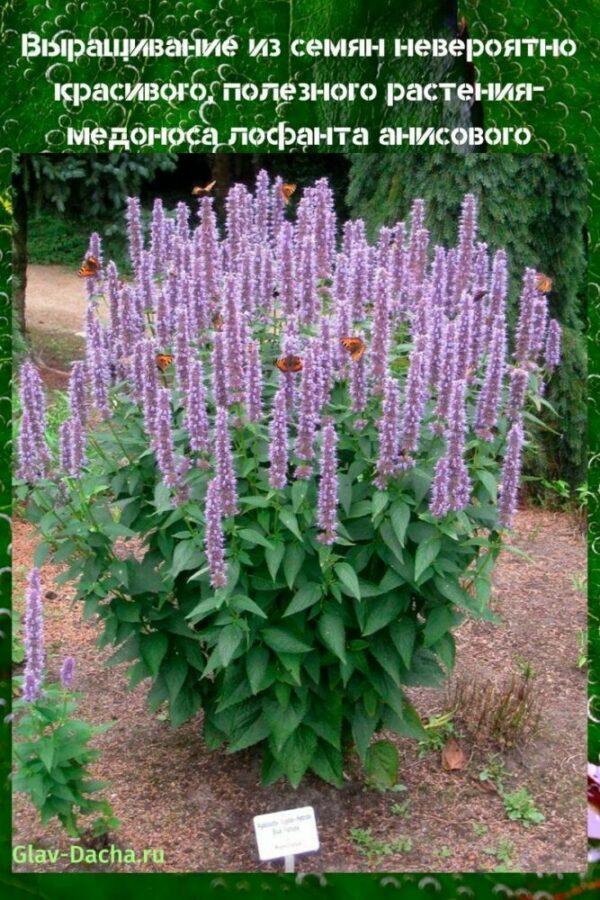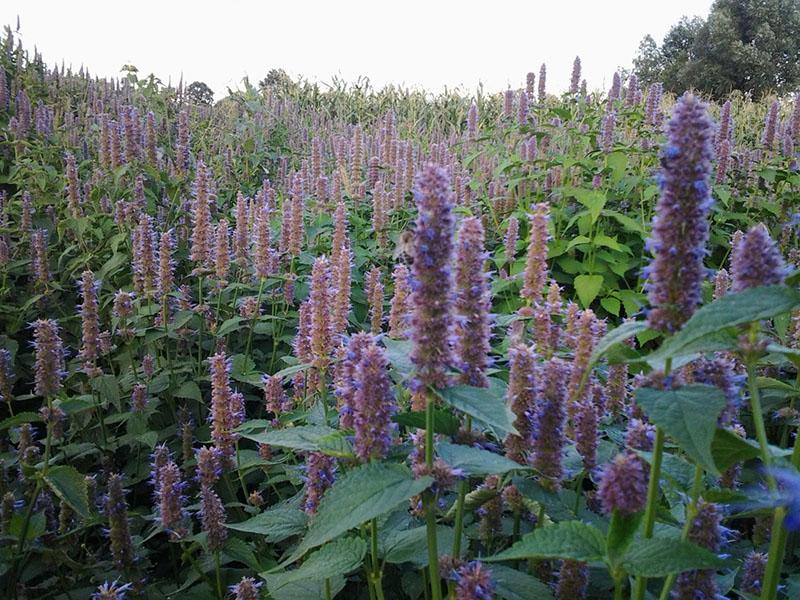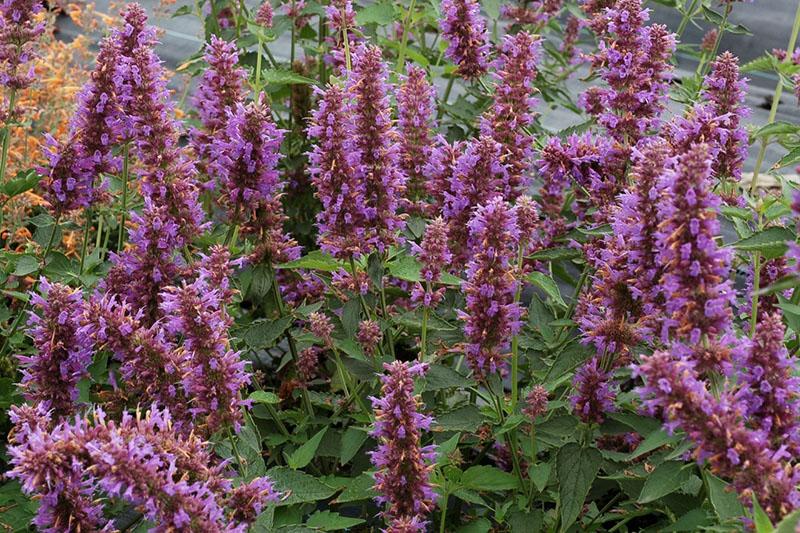Growing from the seeds of an incredibly beautiful, useful melliferous plant of anise lofant
 Gardeners and summer residents love to grow spicy, fragrant and beautiful herbs on their plots, because it is so wonderful to sit on a veranda or bench and look at the huge sea of herbs grown with their own hands. Growing aniseed lofant from seeds is not particularly difficult. As a result, a fragrant and beautiful honey plant will appear on the site, which will fill the air with the aromas of anise.
Gardeners and summer residents love to grow spicy, fragrant and beautiful herbs on their plots, because it is so wonderful to sit on a veranda or bench and look at the huge sea of herbs grown with their own hands. Growing aniseed lofant from seeds is not particularly difficult. As a result, a fragrant and beautiful honey plant will appear on the site, which will fill the air with the aromas of anise.
Plant features

 Anise lofant will undoubtedly attract the attention of lovers of beautiful flowers. These are tall bushes with erect tall stems, growing up to 100-150 cm, with petiolate leaves and spectacular small flowers in the form of large beautiful ears of blue or lilac hue. The anise aroma is given by special essential oils. They attract culinary specialists. Lofant is added to various dishes and preserves. It is planted in separate bushes, beds and even entire plantations when it is required to collect honey from this particular plant.
Anise lofant will undoubtedly attract the attention of lovers of beautiful flowers. These are tall bushes with erect tall stems, growing up to 100-150 cm, with petiolate leaves and spectacular small flowers in the form of large beautiful ears of blue or lilac hue. The anise aroma is given by special essential oils. They attract culinary specialists. Lofant is added to various dishes and preserves. It is planted in separate bushes, beds and even entire plantations when it is required to collect honey from this particular plant.
Growing from aniseed lofant seeds
 Anise lofant has many names (anise hyssop, licorice mint, fennel multicolor). The plant is quite unpretentious in care and soil selection. It grows almost anywhere. But it reaches its maximum size only when choosing a place with good growth conditions. Lofant loves diffused and direct sunlight. Does not tolerate stagnant water, quickly decays. Ideal for it are neutral, sandy loam soils, well-drained.
Anise lofant has many names (anise hyssop, licorice mint, fennel multicolor). The plant is quite unpretentious in care and soil selection. It grows almost anywhere. But it reaches its maximum size only when choosing a place with good growth conditions. Lofant loves diffused and direct sunlight. Does not tolerate stagnant water, quickly decays. Ideal for it are neutral, sandy loam soils, well-drained.
When planting a lofant, it is important to avoid swampy, saline areas with a high groundwater flow. The best neighbors are asters goldenrod, monards. You should not plant it after turnips, turnips, cucumbers, which take all the nutrients from the soil that the lofant most needs.
Anise lofant is grown from seeds in 2 ways:
- seedling;
- reckless.
If the method of growing aniseed lofant from seeds is chosen by direct planting in open beds, then the procedure is carried out in the fall, preferably at the end of October or in the spring in March and April.
With the proposed spring planting of a lofant, the soil is prepared in the fall. They dig it up, removing all the weeds, add 4 kg of humus to each square of soil, add complex mineral additives for flowers.
The seeds need preparation. First, they are disinfected in a slightly pink manganese solution for half an hour. Then they are soaked in a growth stimulator for a day.
Landing is easy. It includes the following steps:
- In the soil, grooves are made with a depth of 0.5 to 1 cm, leaving a distance between the rows of at least 50 cm.
- Spill them with settled water.
- The seeds of the lofant are carefully laid out after some distance.
- They are covered with a layer of earth of small thickness.
- Watering again.
Sprouts appear on day 12-16. As soon as young seedlings form 2-3 pairs of true leaves, the plantings are thinned out, trying to keep at least 25 cm between the nearest "neighbors".
When planting seeds in the fall, they must be protected as much as possible from the upcoming cold weather. For this, the beds are mulched with a large layer of compost, spruce branches, and straw. Only this natural "insulation" does not need to be tamped tightly so that the seeds do not suffocate.
Seedling method
 When sowing seedlings, the seeds are prepared and planted in the last week of March. This method of growing aniseed lofant from seeds is also not difficult.
When sowing seedlings, the seeds are prepared and planted in the last week of March. This method of growing aniseed lofant from seeds is also not difficult.
Standard actions will be required:
- a common box for seedlings or individual pots (cups) are filled with fertile soil;
- each seed is planted in a hole 0.5 cm deep;
- lightly sprinkle with soil;
- watered with warm water;
- covered with polyethylene or glass;
- put away in a warm place.
Before the emergence of shoots, the shelter is removed for a few minutes every day so that the seeds do not become moldy and can germinate normally. Every day, check the moisture content of the soil, focusing on the drying of its top layer. If necessary, spray the soil with water. After 2 weeks, seedlings will hatch. As soon as this happens, the shelter is removed, and the seedlings are transferred to a place where there is most of the sun. Young sprouts of a lofant are watered in a timely manner and every 10 days are fed with complex fertilizers for flowers. A week before the intended planting in the beds in an open place, the seedlings begin to harden, leaving it at an open window or taking it out onto the balcony, first for 5 minutes, but increasing the time spent in the fresh air every day.
 As soon as the seedlings grow green mass (at least 5-6 true leaf blades), they are transplanted to a permanent place in the open field. The earth is preliminarily (at least a couple of days) spilled with a solution of potassium permanganate for disinfection. Each plant is planted in holes with an interval between holes of 20-25 cm.At least 50 cm is left between the rows.When the planting is complete, the Lofant is watered abundantly.
As soon as the seedlings grow green mass (at least 5-6 true leaf blades), they are transplanted to a permanent place in the open field. The earth is preliminarily (at least a couple of days) spilled with a solution of potassium permanganate for disinfection. Each plant is planted in holes with an interval between holes of 20-25 cm.At least 50 cm is left between the rows.When the planting is complete, the Lofant is watered abundantly.
Choosing any method (seedling or seedling) when growing aniseed lofant from seeds, it should be borne in mind that seedling plants bloom 2 months earlier than those grown from seeds sown directly into open ground.
Care rules
 All varieties of lofanta, including anise, belong to unpretentious plants, therefore, they are looked after according to the classical scheme. This is watering, loosening, protection from diseases, feeding.
All varieties of lofanta, including anise, belong to unpretentious plants, therefore, they are looked after according to the classical scheme. This is watering, loosening, protection from diseases, feeding.
Anise lofant, planting and caring for which is very simple, needs watering, but not regularly, as many crops require, but only during periods of prolonged dry weather. It perfectly tolerates a lack of soil moisture. Even in the heat, its foliage looks very bright and fresh, does not fade. Excessive moisture is very harmful to the lofant. He quickly begins to rot, he is attacked by pathogenic microflora, which is actively developing in the swampy soil. Therefore, it is better not to top up the plant than to pour it over, ruining the planting.
The soil is weeded regularly to improve oxygen saturation. Be sure to remove weeds so they don't take nutrients and water from the ground.
 The flowers of aniseed lofant practically do not need feeding, especially if a well-lit place with fertile soil is chosen for planting. Enhanced nutrition is required when the bushes grow and develop poorly. In this case, complex fertilizers are applied, dissolving 30 g of nutrients in 10 liters of water. Foliar fertilizing with microelements can be carried out.
The flowers of aniseed lofant practically do not need feeding, especially if a well-lit place with fertile soil is chosen for planting. Enhanced nutrition is required when the bushes grow and develop poorly. In this case, complex fertilizers are applied, dissolving 30 g of nutrients in 10 liters of water. Foliar fertilizing with microelements can be carried out.
When growing aniseed lofant as a medicinal plant, it is necessary to remove the inflorescences before the seeds ripen in them. Self-seeding significantly weakens the therapeutic properties of the beautiful flower.
Disease and pest resistance
 Anise lofant is very resistant to diseases and damage from pests.Its only weak point is the fear of waterlogged soil and diseases associated with it. If there are a large number of rainy days, then the lofant can hit white spot, rust, powdery mildew. In this case, fungicidal preparations Fundazol, Horus, Oksikhom are used to destroy pathogenic microflora. Powdery mildew is treated with a solution of colloidal sulfur.
Anise lofant is very resistant to diseases and damage from pests.Its only weak point is the fear of waterlogged soil and diseases associated with it. If there are a large number of rainy days, then the lofant can hit white spot, rust, powdery mildew. In this case, fungicidal preparations Fundazol, Horus, Oksikhom are used to destroy pathogenic microflora. Powdery mildew is treated with a solution of colloidal sulfur.
Pests practically do not attack anise lofant due to its rich spicy aroma. It attracts bees, but repels harmful insects. However, if aphids or thrips attack the bushes, they will quickly disappear after treatment with Decis.
Treatment for parasites is carried out not later than a month before the collection of raw materials.
Lofant Anise is grown most often as an annual because of its fear of cold weather. In the fall, it is uprooted and destroyed. The plot is prepared for the spring sowing of new plants. If you still want to grow it as a perennial, then until mid-September, the shoots are shortened to 10 cm and carefully covered with spruce branches, compost, straw, fallen leaves. Under such a shelter, the lofant winters well in the central regions of Russia.
Growing aniseed lofant from seeds is not a big deal. Even a novice florist can handle this. And further care for an unassuming plant is not at all difficult. It is for these qualities that an incredibly beautiful and fragrant flower has become a favorite of many gardeners and summer residents.